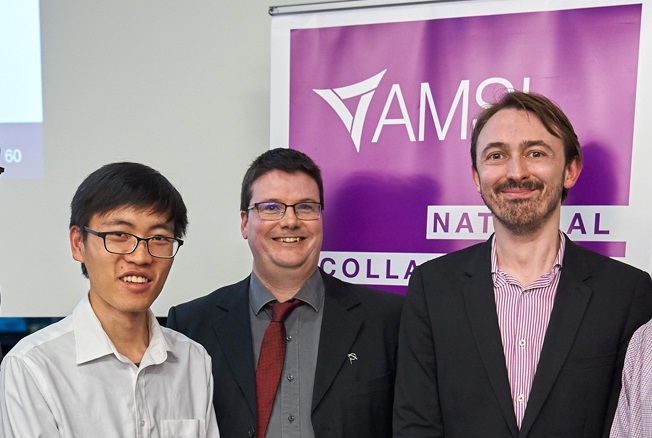By annamuscara
In
2020-06-252020-07-28https://rhed.amsi.org.au/wp-content/uploads/sites/73/2020/06/amsi_rhed_v2-2.pngResearch and Higher Education 200px200px
200px200px
 200px200px
200px200pxMICHAEL ELFORD, DR ANDREW STEPHAN & DR YUNPENG ZHANG, BOEING DEFENCE AUSTRALIA
8 JULY 2019

Michael Elford, Boeing Defence Australia
Michael currently leads the Numerical Simulation in Materials and Manufacturing (NSIMM) group at Boeing Research & Technology Australia (BR&T-A). Michael obtained a Bachelor of Mechanical & Space Engineering at the University of Queensland in 1999 and subsequently a Master of Philosophy in Mechanical Engineering in 2005. Michael has worked for Boeing Defence Australia since 2006, beginning as a structures engineer, and then senior structures engineer, on the F-111 sustainment program. Following on from this in 2011 Michael joined BR&T-A as a senior researcher in the area of advance manufacturing and maintenance.
Dr Andrew Stephan, Boeing Defence Australia
Andrew studied mathematics, physics and statistics at the University of Sydney, graduating with a PhD in applied mathematics in 2016. His research area was in the development of high speed solvers for simulating magnetohydrodynamic (MHD) flow in spherical geometries. Andrew joined Boeing Research and Technology – Australia in 2016 developing software for the high speed simulation of manufacturing processes in sheet metal.
Dr Yunpeng Zhang, Boeing Defence Australia
Yunpeng Zhang received a Bachelor of Engineering and a PhD degree from the University of Queensland (UQ) in 2013 and 2017 respectively. He is currently a postdoctoral research fellow within the School of Mechanical and Mining Engineering at UQ, working for an Advanced Queensland Innovation Partnership project in the topic of Incremental Sheet Forming (ISF). His research interests are applied math, numerical methods, material modelling and optimisation, particularly in the field of engineering. He is an enthusiastic researcher working towards building more bridges between mathematical concepts and the practical world.
| DATE | TIME | PRESENTERS | VENUE |
|---|---|---|---|
| 8 July 2019 | 6.30PM | Michael Elford, Andrew Stephan & Yunpeng Zhang | The Kindler Theatre, GP-P421, Queensland University of Technology, Gardens Point campus |
The production of sheet metal components is an important part of the manufacturing industry and is of critical importance to the aerospace sectors. Sheet metal components are typically formed in a variety of ways. These include utilising the action of fluid pressure, forming with large moving dies or with one or more small tools tracing the contour of a part (incremental sheet forming).
Sheet metal manufacturing processes are limited by geometric and material nonlinearities that impact on the ability to successfully form a part. These include sheet tearing, wrinkling, necking and damage, as well as microstructural changes that occur in the metal itself. These complex phenomena cannot generally be solved for analytically, and hence timely and accurate numerical prediction of these processes is of great interest to the industries that rely on sheet metal manufacturing processes.
Simulation provides an opportunity for virtual optimisation of the process, which can lead to improvements in time, cost, energy overhead and waste (scrapped products and/or forming dies), thereby also providing environmental benefits. The current simulation software available takes a long time to virtually map out a formed part. Boeing and UQ researchers have taken a novel approach to speed up the simulation software by 102 times, using gaming computer graphics cards and mathematics.
In this talk we will explore two different numerical schemes for simulating sheet forming manufacturing processes. The first approach is finite element analysis (FEA) using solid-shell elements. The second is Isogeometric Analysis (IGA) using thick shell elements. Lastly, we will explain the approach to modelling the material behaviour.
This talk will also explore the importance of computational modelling in the wider aerospace industries. Audience members will have the opportunity to see animations of their results, methods for model validation, get a sneak peek at the day-to-day lives of mathematicians working in this exciting field, and find out about opportunities for graduates or interns wanting to pursue a career in this profession.